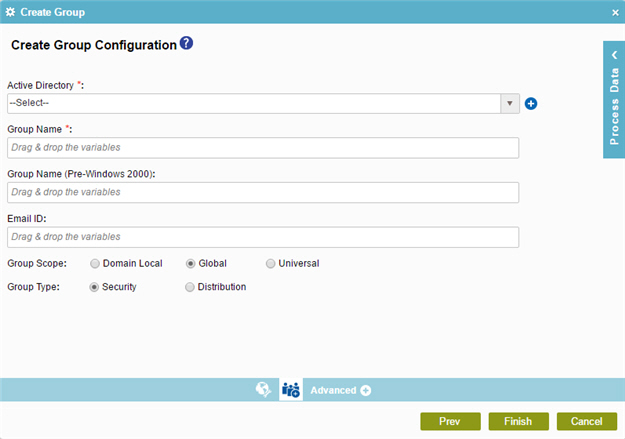Create a Group in Active Directory
To create a group in Active Directory, do the procedure in this topic.

Prerequisites
- Access Tokens for your Active Directory.
Good to Know
- In most text fields, you can use process data variables as an alternative to literal data values.
- You can configure whether this activity waits for other activities before it runs.
For more information, refer to How Do I Configure an Activity to Wait for Other Incoming Activities?
- Some information about third-party integrations is outside the scope of the AgilePoint NX Product Documentation, and it is the responsibility of the vendors who create and maintain these technologies to provide this information. This includes specific business uses cases and examples; explanations for third-party concepts; details about the data models and input and output data formats for third-party technologies; and various types of IDs, URL patterns, connection string formats, and other technical information that is specific to the third-party technologies. For more information, refer to Where Can I Find Information and Examples for Third-Party Integrations?
How to Start
- On the Application Explorer screen, do one of these:
- Do one of these:
- Add an activity:
- In the Process Builder, in the Activity Library,
open the Active Directory
 tab.
tab. - On the Active Directory
 tab,
drag the Create Group (Active Directory)
tab,
drag the Create Group (Active Directory)  activity onto your process.
activity onto your process.
- In the Process Builder, in the Activity Library,
open the Active Directory
- Change an activity:
- In your process, double-click your activity.
- Add an activity:
- Click Create Group
 .
.
Procedure
- On the Create Group Configuration screen, in the Active Directory field, select your Active Directory access token.
To create a new access token, click Add Token
 .
For more information, refer to
Access Token for Active Directory.
.
For more information, refer to
Access Token for Active Directory. - In the Group Name field, enter the name of the group to create in the Active Directory.
- Complete these fields
as necessary.
Field Name Value Group Scope
- Function:
- Specifies where the group exists in Active Directory.
- Accepted Values:
-
- Domain Local - Can have accounts, global groups, and universal groups from any domain and domain local groups within the same domain.
- Global - Can have global groups and accounts from the same domain.
- Universal - Can have accounts, global groups, and universal groups from any domain.
- Default Value:
- Global
- Accepts Process Data Variables:
- No
Group Type
- Function:
- Specifies the group type in Active Directory.
- Accepted Values:
-
- Security - Lets you assign access to resources on your network.
- Distribution - Lets you send e-mails to collections of users with e-mail applications, such as Exchange.
- Default Value:
- Security
- Accepts Process Data Variables:
- No


